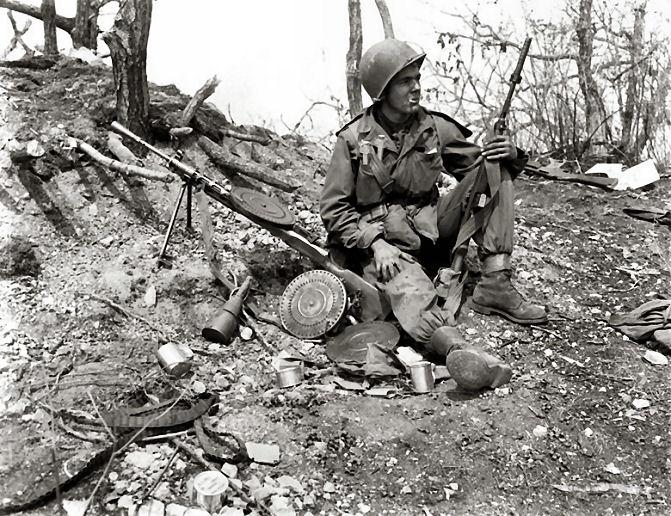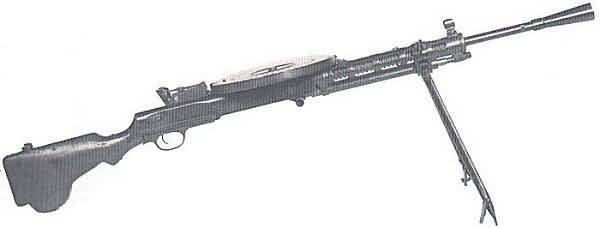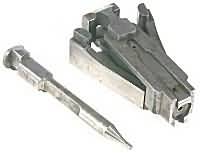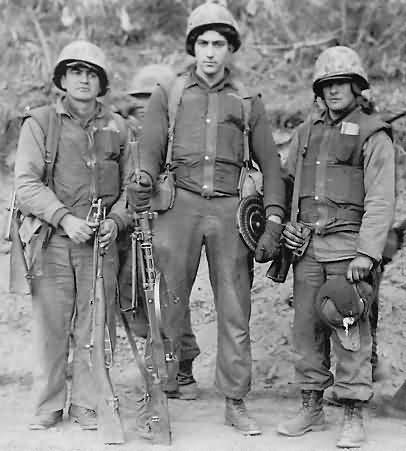The Foundation of Freedom is the Courage of Ordinary People History  On Line On Line |
DP 7.62 mm Ruchnoy Pulemyot Light Machine Gun Automatic fire, 20 lb 8 oz unloaded, 47 round detachable pan magazine, rate of fire about 500-600 rpm, muzzle velocity about 2760 fps, 148 gr bullet, range about 1000 meters. 
Pfc. Julias Van Den Stock of Company A, 32nd Regimental Combat Team, 7th Infantry Division with M1 or M2 Carbine, rests on a Chinese Communist bunker with a Soviet DP light machine gun, along the slope of Hill 902 north of Ip-Tong. Note the carbine mounts a rifle grenade launcher, which uses rifle grenades, but the two handles in front of his right shoulder are Chinese stick grenades.

DP 7.62 mm Ruchnoy Pulemyot Light Machine Gun

Operation: Automatic fire, only
Length: 50.8 in. (1290 mm)
Weight unloaded: 20 lb 8 oz (9.12 kg)
Barrel: 23.8 in. 4 grooves, right hand twist
Magazine: 47 round detachable pan
Cyclic Rate: 500-600 rpm
Muzzle velocity: 2760 fps, 2900 ft-lb
Ammunition: 148 gr bullet, 48 gr charge, Russian Light Ball M'08
Effective Range: Probably about 1000 meters
| The 7.62 mm Ruchnoy Pulemyot DP (Degtyaryova pakhotnyi) was adopted by the Soviet army in 1928. It is extremely simple, yet remarkably reliable and robust. It remained the standard light gun until the 50's, and the USSR supplied large numbers of them to the North Korean Communists in the Korean war. The secret of the DP was the simple locking device, which made use of locking flaps on the bolt, pushed out by the firing pin. | |

| The DP uses a long stroke gas piston, located under the barrel, which operates a bolt with two side-mounted locking flaps. When the bolt comes into the battery the stud, mounted on the bolt carrier, pushes the firing pin forward. A thick part of the firing pin swings the rear parts of the locking flaps out of bolt and into the locking recesses in the receiver walls. When the shot is fired, a bolt carrier on its way back retracts the flaps out of receiver walls into the bolt and then opens the bolt. The DP fires from the open bolt. | One of the few drawbacks was that the recoil spring was located under the barrel, around the gas piston, and the spring tended to loose its temper due to overheating. Another drawback was the flat pan magazine, necessary for the rimmed cartridges available at the time but too heavy, awkward to carry and easily damaged. When the DP was improved as the model DPM, the main improvements were relocating the recoil spring to the rear of the bolt, and an extension added behind the receiver to contain the spring. This forced redisigning the stock with a pistol grip. | |

|  | | Three Marines from Company F, 2nd Battalion, 5th Marines who participated in the raid on Hill 15 (Detroit) display captured enemy weapons and materials. The Marine on the left has a Moisin Nagant while the Marine in the center holds a DP (DP 7.62 mm Ruchnoy Pulemyot Light Machine Gun).
|
Causes of the Korean Tragedy ... Failure of Leadership, Intelligence and Preparation
The Foundations of Freedom are the Courage of Ordinary People and Quality of our Arms
|

